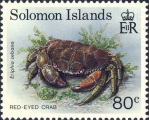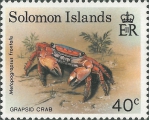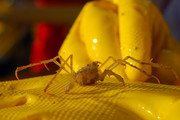Decanet taxon details
Pelia mutica (Gibbes, 1850)
158440 (urn:lsid:marinespecies.org:taxname:158440)
accepted
Species
Pisa mutica Gibbes, 1850 · unaccepted > superseded combination
marine, brackish, fresh, terrestrial
recent only
(of Pisa mutica Gibbes, 1850) Gibbes, L.R. (1850). On the carcinological collections of the United States, and an enumeration of species contained in them, with notes on the most remarkable, and descriptions of new species. <em>Proceedings of the American Association for the Advancement of Science.</em> 3: 165-201. [details] 
Depth range Shallow-waters (0-100 m)
Distribution Buzzards Bay and Vineyard Sound, Mass., to off Port Mansfield, Willacy Co., Tex.; Cuba, Puerto Rico and St. Thomas, West...
Depth range Shallow-waters (0-100 m) [details]
Distribution Buzzards Bay and Vineyard Sound, Mass., to off Port Mansfield, Willacy Co., Tex.; Cuba, Puerto Rico and St. Thomas, West...
Distribution Buzzards Bay and Vineyard Sound, Mass., to off Port Mansfield, Willacy Co., Tex.; Cuba, Puerto Rico and St. Thomas, West Indies. [details]
DecaNet eds. (2025). DecaNet. Pelia mutica (Gibbes, 1850). Accessed at: https://www.decanet.info/aphia.php?p=taxdetails&id=158440 on 2025-09-11
Date
action
by
original description
(of Pisa mutica Gibbes, 1850) Gibbes, L.R. (1850). On the carcinological collections of the United States, and an enumeration of species contained in them, with notes on the most remarkable, and descriptions of new species. <em>Proceedings of the American Association for the Advancement of Science.</em> 3: 165-201. [details] 
basis of record Pollock, L.W. (1998). A practical guide to the marine animals of northeastern North America. Rutgers University Press. New Brunswick, New Jersey & London. 367 pp., available online at http://books.google.com/books?id=i1AmT31cuR4C [details]
additional source Felder, D. L., Álvarez. F.,Goy, J.W. & Lemaitre, R. (2009). Decapoda (Crustacea) of the Gulf of Mexico, with comments on the Amphionidacea,. <em>Felder, D.L., and Camp, D.K. (eds), Gulf of Mexico - Origins, Waters, and Biota. Vol. 1. Biodiversity.</em> Pp. 1019–1104 (Texas A&M University Press: College Station, Texas)., available online at http://biogomx.net/sites/default/files/pdfs/chapters/59-Felder%20et%20al%202009-Decapoda%20of%20the%20GoMx.pdf [details]
additional source Williams, A. B. (1984). Shrimps, Lobsters, and Crabs of the Atlantic Coast of the Eastern United States, Maine to Florida. <em>Smithsonian Institution Press.</em> [details] Available for editors
additional source Integrated Taxonomic Information System (ITIS). , available online at http://www.itis.gov [details]
basis of record Pollock, L.W. (1998). A practical guide to the marine animals of northeastern North America. Rutgers University Press. New Brunswick, New Jersey & London. 367 pp., available online at http://books.google.com/books?id=i1AmT31cuR4C [details]
additional source Felder, D. L., Álvarez. F.,Goy, J.W. & Lemaitre, R. (2009). Decapoda (Crustacea) of the Gulf of Mexico, with comments on the Amphionidacea,. <em>Felder, D.L., and Camp, D.K. (eds), Gulf of Mexico - Origins, Waters, and Biota. Vol. 1. Biodiversity.</em> Pp. 1019–1104 (Texas A&M University Press: College Station, Texas)., available online at http://biogomx.net/sites/default/files/pdfs/chapters/59-Felder%20et%20al%202009-Decapoda%20of%20the%20GoMx.pdf [details]
additional source Williams, A. B. (1984). Shrimps, Lobsters, and Crabs of the Atlantic Coast of the Eastern United States, Maine to Florida. <em>Smithsonian Institution Press.</em> [details] Available for editors
additional source Integrated Taxonomic Information System (ITIS). , available online at http://www.itis.gov [details]
 Present
Present  Inaccurate
Inaccurate  Introduced: alien
Introduced: alien  Containing type locality
Containing type locality
From regional or thematic species database
Introduced species remark Brazilian part of the South Atlantic Ocean (Marine Region) It is also quite probable that this insignificant species was simply overlooked and has occurred in Brazil for a period of time, being misidentified as Pelia rotunda, as this is the only species of the genus described in Brazil (Melo, 1996). The lack of nocturnal dive surveys when P. mutica is most active (Williams, 1984) may also be a reason for its non-identification. [details]Introduced species vector dispersal Brazilian part of the South Atlantic Ocean (Marine Region) Pathway/vector Other [In the case of Pelia mutica, it may have been introduced by ballast water or possibly as a result of its popularity with aquarists. As it is was a common ornamental species commercially traded within the aquaria industry (Calado et al., 2003). Another explanation to its presence is that of natural dispersion through the counter-flowing North-Brazilian current, which crosses the biogeographic barrier of the Amazon-Orinoco plume. However large dispersions such as this seems improbable for a small cryptobenthic crab, inhabiting a shallow water niche (Williams, 1984).] [details]
Unreviewed
Association Associated with sponges [details]Depth range Shallow-waters (0-100 m) [details]
Distribution Buzzards Bay and Vineyard Sound, Mass., to off Port Mansfield, Willacy Co., Tex.; Cuba, Puerto Rico and St. Thomas, West Indies. [details]
| Language | Name | |
|---|---|---|
| English | cryptic teardrop crab | [details] |
To Barcode of Life (5 barcodes)
To Biodiversity Heritage Library (42 publications)
To CRUSTA
To European Nucleotide Archive, ENA (Pelia mutica)
To GenBank (4 nucleotides; 1 proteins)
To Global Biotic Interactions (GloBI)
To USNM Invertebrate Zoology Arthropoda Collection (50 records)
To Yale Peabody Museum of Natural History (YPM IZ 030805)
To ITIS
To Biodiversity Heritage Library (42 publications)
To CRUSTA
To European Nucleotide Archive, ENA (Pelia mutica)
To GenBank (4 nucleotides; 1 proteins)
To Global Biotic Interactions (GloBI)
To USNM Invertebrate Zoology Arthropoda Collection (50 records)
To Yale Peabody Museum of Natural History (YPM IZ 030805)
To ITIS




